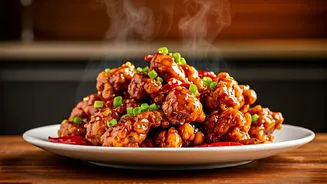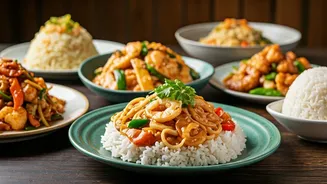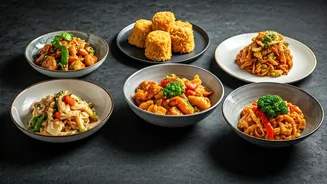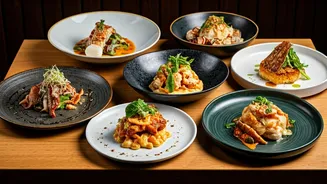The Story of Chop Suey
Chop Suey, a dish of mixed ingredients typically including meat and vegetables served in a thickened sauce, is a perfect example of a dish that's often
misattributed. While many associate it with Chinese cuisine, the true origins of Chop Suey are quite debatable. There are varying tales, with some pointing towards a late-night creation by Chinese chefs in America. One story suggests it was a quick meal made to satisfy hungry miners, while another claims it was a random combination of leftovers. The key takeaway is that Chop Suey, despite its Chinese association, is largely an American invention, a testament to culinary adaptation and the merging of cultures. Its very nature is a blend of whatever was available, reflecting a resourceful approach to cooking and the creation of something new from existing ingredients.
The Allure of Fortune Cookies
Fortune cookies, small, crisp cookies containing a 'fortune' or prediction, are a staple in many Chinese restaurants in Western countries. Yet, they are not typically found in China. The origin is generally traced back to Japanese or American influences, rather than Chinese culinary practices. Various theories abound, with some historians suggesting that Japanese immigrants in the US created them in the early 20th century. Others propose that Chinese immigrants adopted the idea and popularized it. The presence of fortune cookies reflects the complex cultural exchange and evolution of food. They're a prime example of how dishes can be adopted and changed as they traverse and adapt to different environments. This cultural exchange has made them a much-loved novelty.
Sweet and Sour Pork
Sweet and sour pork is another dish celebrated globally as Chinese, however, its widespread adaptation across the globe has transformed it from its traditional roots. While it's undeniably popular in Chinese restaurants, the versions found internationally often differ significantly from those in China. The dishes' evolution shows how local tastes play a role in shaping cuisine. Many international versions embrace sweeter and tangier flavors, catering to a broader audience. These variations reflect the willingness of chefs and restaurants to tailor the taste to the preferences of their clientele. This dish is a good example of how cuisine adapts as it moves across borders.
General Tso's Chicken's Rise
General Tso's Chicken, a dish of battered, deep-fried chicken pieces coated in a sweet and spicy sauce, enjoys a huge popularity in many parts of the world. The connection to China may not be as direct as most assume. The dish is believed to have originated in the United States, named after a Qing dynasty general. It was designed to cater to the American palate. The dish's evolution reflects the merging of culinary styles and the creation of something new. It is a symbol of American-Chinese cuisine. The origins and adaptation of the dish show how recipes can change when they cross cultural boundaries.
Egg Rolls vs. Spring Rolls
Egg rolls, often found on Chinese restaurant menus, are quite a distinct dish when compared to their purported origins. While the concept may be related to traditional spring rolls, the American egg roll has significant differences. The crisp, thick, deep-fried wrappers, and the ingredients used often set it apart from its more delicate counterparts. Spring rolls, on the other hand, are typically lighter, with a thinner wrapper. This divergence highlights the transformation of dishes as they adapt and are reinterpreted. The egg roll illustrates the influence of culinary innovation. This makes a case of how a basic culinary concept can be reshaped to satisfy tastes.
Crab Rangoon: A Delight
Crab Rangoon, small, deep-fried wontons filled with a mixture of cream cheese, crab meat, and seasonings, is frequently presented as a Chinese appetizer. Its origins are actually not in China. It's believed to be an American invention, likely inspired by Polynesian cuisine. The dish is an example of culinary inspiration. This dish has created a flavor combination that has become a familiar menu staple in many Chinese-American restaurants. The story of Crab Rangoon shows how dishes can emerge from cultural exchanges and the blending of traditions, resulting in an original culinary creation. The dish’s origins are a testament to how flavors and techniques can transform through cultural adaptations.













